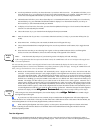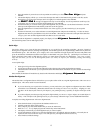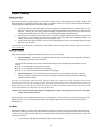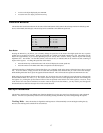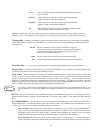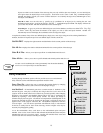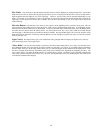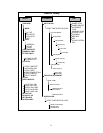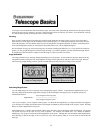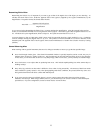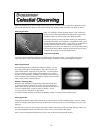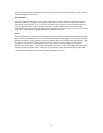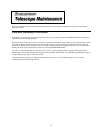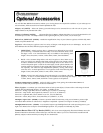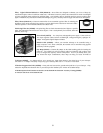
22
Correct image as viewed when
using erect image diagonal
Inverted image, as viewed with
the eyepiece directly in telescope
A telescope is an instrument that collects and focuses light. The nature of the optical design determines how the light is focused.
Some telescopes, known as refractors, use lenses. Other telescopes, known as reflectors, use mirrors. Your NexStar 80 telescope
is a refractor telescope that use an objective lens to collect its light.
F
F
o
o
c
c
u
u
s
s
i
i
n
n
g
g
Once you have found an object in the telescope, turn the focusing knob until the image is sharp. To focus on an object that is
nearer than your current target, turn the focusing knob toward the eyepiece (i.e., so that the focusing tube moves away from the
front of the telescope). For more distant objects, turn the focusing knob in the opposite direction. To achieve a truly sharp focus,
never look through glass windows or across objects that produce heat waves, such as asphalt parking lots.
For astronomical viewing, out of focus star images are very diffuse, making them difficult to see. If you turn the focus knob too
quickly, you can go right through focus without seeing the image. To avoid this problem, your first astronomical target should
be a bright object (like the Moon or a planet) so that the image is visible even when out of focus.
I
I
m
m
a
a
g
g
e
e
O
O
r
r
i
i
e
e
n
n
t
t
a
a
t
t
i
i
o
o
n
n
The image orientation of any telescope changes depending on how the eyepiece is inserted into the telescope. When observing
through the NexStar 80 using the erect image diagonal, the image will be right side up, and correct from left to right. However,
when observing straight through, with the eyepiece inserted directly into the telescope, the image will be inverted.
C
C
a
a
l
l
c
c
u
u
l
l
a
a
t
t
i
i
n
n
g
g
M
M
a
a
g
g
n
n
i
i
f
f
i
i
c
c
a
a
t
t
i
i
o
o
n
n
You can change the power of your telescope just by changing the eyepiece (ocular). To determine the magnification of your
telescope, simply divide the focal length of the telescope by the focal length of the eyepiece used. In equation format, the
formula looks like this:
Focal Length of Telescope (mm)
Magnification = ⎯⎯⎯⎯⎯⎯⎯⎯⎯⎯⎯⎯⎯⎯
Focal Length of Eyepiece (mm)
Let’s say, for example, you are using the 25mm eyepiece. To determine the magnification you simply divide the focal length of
your telescope (for example, the NexStar 80 has a focal length of 900mm) by the focal length of the eyepiece, 25mm. Dividing
900 by 25 yields a magnification of 36 power.
Although the power is variable, each instrument under average skies has a limit to the highest useful magnification. The general
rule is that 60 power can be used for every inch of aperture. For example, the NexStar 80 is 3.1” (80mm) in diameter.
Multiplying 3.1 by 60 gives a maximum useful magnification of 186 power. Although this is the maximum useful magnification,
most observing is done in the range of 20 to 35 power for every inch of aperture which is 62 to 109 times for the NexStar 80
telescope.



